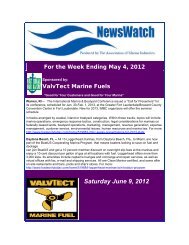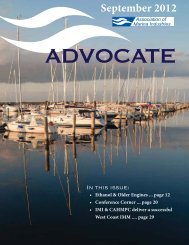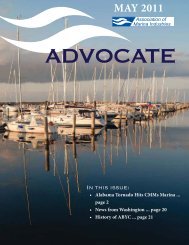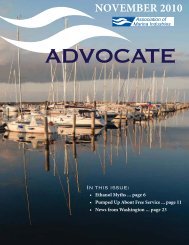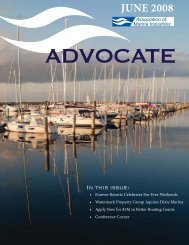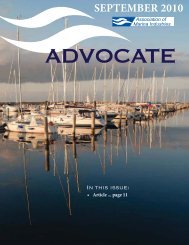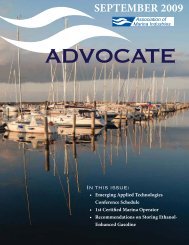Download a copy of AMI's Clean Marina best management practices ...
Download a copy of AMI's Clean Marina best management practices ...
Download a copy of AMI's Clean Marina best management practices ...
Create successful ePaper yourself
Turn your PDF publications into a flip-book with our unique Google optimized e-Paper software.
• Place a second <strong>copy</strong> <strong>of</strong> the Spill Response Plan in the oil spill response kit.<br />
• Review plans and response procedures with staff at the beginning <strong>of</strong> each boating season.<br />
• Train employees in the use <strong>of</strong> containment measures.<br />
• Run emergency response drills at least twice annually.<br />
• Invite the U.S. Coast Guard and local fire departments to demonstrate emergency response procedures at<br />
your marina.<br />
Be Prepared for a Fire<br />
• Meet the National Fire Protection Association’s standards for marinas: NFPA 303, Fire Protection<br />
Standards for <strong>Marina</strong>s and Boatyards; VFPA 302, Fire Protection Standards for Pleasure and<br />
Commercial Motor Craft; NFPA 30A, Automotive and Marine Service Station Code; NFPA 307,<br />
Standard for the Construction and Fire Protection <strong>of</strong> Marine Terminals, Piers, and Wharves; and<br />
NFPA 33, Standard for Spray Application Using Flammable and Combustible Materials.<br />
• Be sure hydrants are available to allow for fighting fires throughout your facility. (This can include dry<br />
hydrants.)<br />
• Install smoke detectors.<br />
• Provide and maintain adequate, readily accessible, and clearly marked fire extinguishers on each dock<br />
and one on the fuel dock within 25’ <strong>of</strong> the head <strong>of</strong> the gangway to the dock<br />
• Provide metal containers with tight-fitting or self-closing metal lids for the temporary storage <strong>of</strong><br />
combustible trash<br />
• Post warning signs at the face <strong>of</strong> each wharf, pier or float at an elevation clearly visible from the decks<br />
<strong>of</strong> boats being fueled. Letters on the signs shall be at least 3 inches in height. NFPA requires signs to<br />
include the following:<br />
WARNING-NO SMOKING.<br />
STOP ENGINE WHILE FUELING,<br />
SHUT OFF ELECTRICITY<br />
DO NOT START ENGINE UNTIL AFTER<br />
BELOW DECK<br />
SPACES ARE VENTILATED<br />
EPA requires a sign directly on fuel pumps stating:<br />
FOR OFF-ROAD USE ONLY<br />
The IRS also requires signs to be posted on fuel dispensing equipment stating:<br />
LOW SULFUR NON-HIGHWAY DIESEL FUEL<br />
(NOT TO EXCEED 500 PPM SULFUR)<br />
WARNING<br />
FEDERAL LAW PROHIBITS USE IN MODEL YEAR 2007 AND LATER, NON-HIGHWAY<br />
VEHICLES AND ENGINES.<br />
ITS USE MAY DAMAGE THESE VEHICLES AND ENGINES.<br />
TAX EXEMPT. DYED. FOR OFF ROAD USE ONLY. PENALTY FOR TAXABLE USE.<br />
• Inspect and test all fire fighting equipment and systems regularly.<br />
• Train personnel on fire safety and response: who to call, location <strong>of</strong> hydrants, use <strong>of</strong> portable<br />
extinguishers, etc.<br />
• Provide ready access to all piers, floats, and wharves for municipal fire fighting equipment.<br />
• Invite the local fire marshal to visit your marina annually to train employees. These annual visits will<br />
also help the fire department to become familiar with your facility.<br />
5



